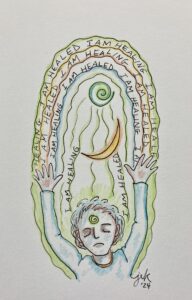
-Artwork © 2024 Jan Ketchel
In a conversation, I joked that I couldn’t remember the last time I’d seen a doctor. I knew immediately that the die had been cast. Send out a message like that and you’ve invited a stream of subliminal thought forms, with contrary suggestions, to compete with your own intent. What inside me was being so careless, or so determined?
Days later, I noticed a tickle and niggling cough throughout the day. By the end of the day a dizziness set in, an intense vibratory disorientation, coupled with a chill that had me wear a wool vest and wrap up in a blanket, despite the 80 + degree temperature of the day.
I consented to a thermometer, which revealed a heightened temperature. Suggestions of covid, flu or, at the very least, the onset of a course of a lengthy cold emerged. It was clear to me that these were all genuine possibilities.
A chain of associations began to present themselves to support and prepare for a healing process of several days. Although this would be a quite legitimate course of care, I seized upon this unusual opportunity to test my soul’s ability, via autosuggestion, to alter the natural course of my recovery. And so, I’ve decided to share how I practice what I preach!
My stated intent was to completely resolve these symptoms so that I would be present, in optimal physical health, with maximal clinical and intuitive acuity, for a full day of meetings starting at 7 am the following morning.
I instructed my subconscious: “My body is healing, my body is healed.”
I repeated it incessantly, coupling it with an eight count breathing pattern, saying the first part of the phrase with a four-count in breath and the latter part with a four-count out breath. By 7 pm I was so tired and disoriented that I collapsed into bed.
A restlessness slowly crept in and I knew there would be no rest if I remained in the bedroom. I relocated myself to the living room, which was quite warm, yet I shook with chills and knew that air conditioning was not an option. I considered an ibuprofen. I flipped a coin and got tails: No, to ibuprofen. If I was to be sincere in my commitment to a clean experiment, my only intervention could be: “My body is healing, my body is healed.”
I began to experience a throbbing headache that came and went, seemingly for hours. I did allow myself to utilize a well-anchored healing suggestion: “My headache is healing, my headache is healed.” Though effective immediately, the duration of relief was no more than a couple of minutes before its vicious return. I finally decided to recite only my eight count breathing and body healing suggestion.
I attempted to lie down but was continuously bombarded with a smorgasbord of pain sensations and dizziness. I could not find my calm center. I felt myself on the acute edge of annihilation. My only momentary glimpse of a potential grounding was noticing the autonomous playing of the synchronous rhythm that had been established by my incessant eight count breath.
For the next four hours I caved to the relief of restless shifting: laying one way on the couch, then the opposite; changing pillows, throwing pillows, no pillows; collapsing onto the floor, turning over, feet up on the coffee table, the contents of which became strewn about the room. I’d sit momentarily in different positions, in different chairs; nothing offered a moment’s peace.
A sensation of nausea flirted in the background. It invited the suggestion of immediate relief through facilitated release. I refused. “If that is to happen, let it happen on its own,” I insisted. Despair and futility dragged me into the underworld of self-pity and fraudulence. I began actually to wonder if I needed the rescue squad to bring me to the ER. Thoughts of physical death seemed a genuine possibility.
Eventually, I was so despondent that I sat and silently cried out to my High Self and teachers for help! No one came. I sank to the rock bottom depression of, “Why have you forsaken me?” I was sitting curled up in a chair when I noticed that I might have dozed off for a moment. An inkling of constancy of presence appeared. “Might I be able to sleep?” I pondered.
It was 1:30 am. I knew that in order to be able to practice in the morning I’d have to be 100% healed by 3:15 am. This seemed utterly impossible. I hadn’t slept at all, my symptoms were all still fully present, but I had had a calm moment. I closed my eyes. I awoke at 2:30, no change. I told my subconscious, which never fails at a wakeup request, to wake me at 3:15. I drifted off immediately.
I next awoke to Jan checking on me at 3:30 am. Wow, my subconscious had not responded to my 3:15 am suggestion! I let it go. The room was a mess, but I wasn’t! No temperature. No headache. No dizziness. No nausea. No vibratory shakiness. Full calm breaths. Utter clarity. Well rested.
We went for a walk, did some reading. My thinking and intuition were clear as a bell. I showered, had some breakfast and started my day at 7 am, finishing at 5 pm, without a glitch. Subsequent days were equally symptom free.
My medicine journey, initiated by the active substance of my self-important comment, showed me how far the soul could potentially go to accelerate the action of the innate healing archetypes latent in the physical body.
I arrived at the experience of total transformation, as my subconscious led me rapidly through the stages of healing at light speed to meet my stated deadline intent. Mine was but one dark night of the soul.
The physical body is its own entity, separate and distinct from its companion soul. Often, when the soul has decided it’s time to leave this life, the physical body resists, clinging to life for extended periods of time. The soul cannot fully break the cord and be free until the body acquiesces to its own physical death.
The soul body entered and attached to the physical body before birth. Both bodies agreed to a relationship for a human lifespan for reasons which benefit each individually. For the body, the conservative evolutionary archetypes that rule it are introduced to new possibilities through the soul’s suggestions. For the soul, the depth of its experience gained through a drama lived in a physical body deeply enhances its knowing of all that is.
The body has a powerful set of rules that independently govern the course of physical life. The body is prepared to live the stages of life, grow old and die. The soul, through its subconscious mind, assumes full control of the human body, though it generally acquiesces to run the body’s evolutionarily established healing programs.
However, the soul, which operates under different rules than the physical body, can think and suggest outside the instinctive box. Thus, the soul knows that beyond heredity and the rules that govern physical life, a suggestion such as I made, to heal from an infection, within hours as opposed to days, is possible.
Of course, the soul cannot change the fact that, ultimately, the physical body will die. Some shamans, called death defiers, have been able to delay death for generations, but ultimately have had to eventually surrender their physical counterparts to death.
Nonetheless, the soul can contribute greatly to the health and healing of the physical body, particularly through the use of autosuggestion. At times it can indeed achieve miracle cures. Modern medicine has yet to discover this healing potential, as it remains almost exclusively focused on the material workings of the physical body.
The most important variable to approaching the subconscious mind with healing suggestions is to have faith that anything is possible, to swiftly release any doubt and stay focused on the intent. This guarantees nothing, but without it, suggestions lack the potency of conviction needed to attract the subconscious mind’s attention.
No attachment to outcome. No shirking of the responsibility to also explore the best that mainstream medicine has to offer. Assume full responsibility for life. Explore your full potential. See what happens!
My body is healed,
Chuck



